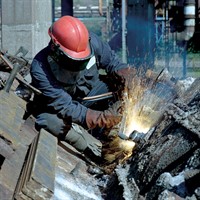Welding

Welding processes expose workers (welders, flame cutters and
burners) to many hazards including the inhalation of toxic welding
fumes and gases. Exposure to welding fumes can occur through
inhalation, dermal and eye contact. Welding fumes are the
fumes that result from various welding operations.
Welding fumes typically have a metallic odour.
Their specific composition varies considerably depending on the
type of welding and the material being welded; the primary
components involved are oxides of the metals such as zinc, iron,
chromium(VI), aluminium, copper or nickel.
Biological monitoring can assess exposure by all routes
inhalation, ingestion and skin absorption. A simple urine
sample can provide information about an individual worker's
exposure to the metals commonly found in welding fumes. In
the case of welding, biological monitoring can specifically help to
assess efficacy of the respiratory and personal protection
equipment (RPE/PPE) being used. In February
2020 new
guidance about LEV and RPE for mild steel welding was issued by
HSE and there are workplace actions required to comply with the
guidance.
An elevated urine result would suggest the worker has some
welding fume exposure and that the RPE/PPE/engineering controls
need to be improved. Biological monitoring is suitable for
regular monitoring to check that systems are working correctly and
for investigating the extent of exposure following incidents.
Biological monitoring for welders should include the measurement
of
nickel and chromium in a urine
sample and this should be undertaken on an annual basis where there
is shown to be good control. Samples should be collected at the end
of a typical working week -
online ordering is available. It may also be possible to
monitor for other metals depending on the type of metal being
welded, for example manganese and copper for mild steel, aluminium
for alloyed steels, beryllium in copper beryllium alloy.
Cadmium or lead should be measured if the stainless steel has been
cadmium plated or if lead paint (lead oxide primer) is
present. To determine recent exposure to both cadmium and
lead a blood sample is required. See the table below for
other metals that can be involved in each welding process.
If workers experience symptoms
consistent with metal fume fever or feel unwell outside of the
normal biological monitoring regime, a urine sample should be taken
as soon as possible to allow any exposure to be confirmed.
For further information about all types of welding information
and safety, please visit: https://www.hse.gov.uk/welding/
Types of welding, principal metals involved and advised
biological monitoring (bold - testing recommended,
italics - testing to be considered, if a constituent).
| Type of Welding |
Material welded |
Metals involved in weld type |
| Flux cored arc |
Mild steel and low alloy steels
Stainless Steel
Nickel alloys
|
Chromium, Nickel,, Aluminium,
Copper, Iron, Barium, Vanadium, Titanium
|
|
Manual Metal arc (flux shielded manual metal arc) (SMAW/MMA or
MMAW)
|
Mild steel and low alloy steels
Stainless Steel,
Al,Cu, Ni Alloys, cast iron and hardfacing
|
Chromium, Nickel, Aluminium,
Copper, Iron, Manganese, Vanadium,
Titanium, Molybdenum, Antimony.
|
|
Metal inert gas (MIG, gas metal arc, GMAW)
|
Mild steel and low alloy steels
Stainless Steel
Aluminium alloys
|
Chromium, Nickel, Aluminium, Silicon,
Copper, Manganese, Iron, Beryllium,
Arsenic, Vanadium, Titanium,
Antimony.
|
|
Tungsten Inert gas (TIG, gas tungsten arc welding)
|
Mild steel and low alloy steels
Stainless Steel
|
Chromium, Nickel, Aluminium,
Magnesium, Copper, Iron, Tungsten,
Vanadium, Titanium.
|
|
Gas Welding
|
Mild Steel
Lead flashing
|
Chromium, Nickel, Aluminium,
Copper, Iron, Cobalt, Lead.
|
Back to the top